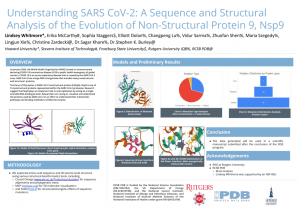Whitmore, Lindsey: Understanding SARS CoV-2: A Sequence and Structural Analysis of the Evolution of Non-Structural Protein 9, Nsp9
Title: Understanding SARS CoV-2: A Sequence and Structural Analysis of the Evolution of Non-Structural Protein 9, Nsp9
Name: Lindsey Whitmore
Home Institute: Howard University
Programs: RISE program, Protein Data Bank
Other contributors: Erika McCarthy, Sophia Staggers, Elliott Dolan, Changpeng Lu, Vidur Sarma, Zhuofan Shen, Maria Szegedy, Lingjun Xie, Christine Zardecki, Dr.Sagar Khare, Dr.Stephen K. Burley
Abstract: In January 2020, the World Health Organization (WHO) issued an announcement declaring COVID-19 (coronavirus disease 2019) a public health emergency of global concern. COVID-19 is an acute respiratory disease that is caused by the SARS CoV-2 virus. SARS CoV-2 has a large RNA viral genome that encodes many nonstructural and structural proteins. As part of an online summer research experience with the RCSB PDB, we studied how SARS-CoV-2 proteins evolved during the first six months of the COVID-19 pandemic by exploring amino acid sequence and 3D atomic-level structure using various structural bioinformatics tools, including Clustal Omega (www.ebi.ac.uk/Tools/msa/clustalo/) for sequence alignments and phylogenetic trees; Mol* (molstar.org) for 3D molecular visualization; and Foldit (fold.it) for structural/energetic effects of sequence mutations. The focus of this poster is SARS CoV-2 nonstructural protein 9 (Nsp9). Nsp9 is one of 16 nonstructural proteins represented within the SARS CoV-2 proteome. Research suggests that Nsp9 plays an important role in viral replication by acting as a single stranded RNA binding protein. This project aims to further the collective understanding of SARS-CoV-2 by performing a thorough structural and functional analysis of the various proteins within its genome.
Biography: Lindsey Whitmore is a second-year honors chemistry major, biology and mathematics double minor at Howard University. She entered the program with advanced standing, due to earning an Associate of Science Degree while she was in high school and has used her unique position to pursue cross-disciplinary studies in engineering, computer science, and upper-level mathematics in addition to the chemistry core curriculum. She attends Howard as a member of the Karsh STEM Scholars program (formerly Bison STEM Scholars Program), a program committed to increasing the number of underrepresented minorities who earn a Ph.D., or combined M.D.-Ph.D. in STEM-related disciplines. Lindsey has a strong interest in conducting interdisciplinary research in translational medicine with a focus on drug discovery and plans to earn a Ph.D. in Medicinal Chemistry. This summer, she worked with the RCSB Protein Data Bank and studied the evolution of the SARS CoV-2 virus by evaluating the energetic consequences of amino acid changes of SARS CoV-2 proteins throughout the first six months of the pandemic and the impact of these changes on the plasticity of protein structure.
